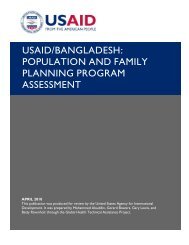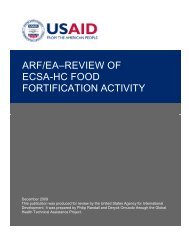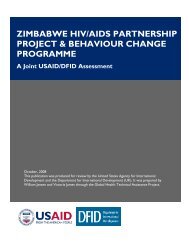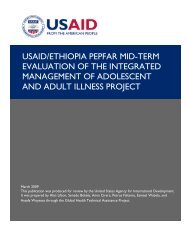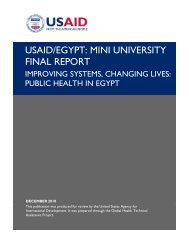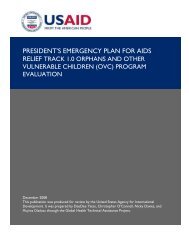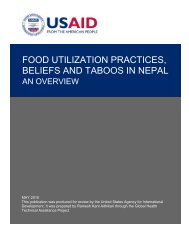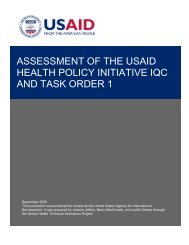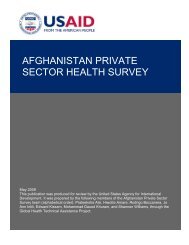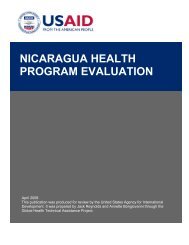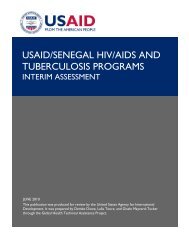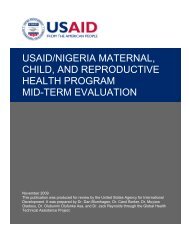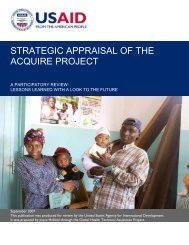Evaluation of the Tuberculosis Control Assistance Program (TB CAP)
Evaluation of the Tuberculosis Control Assistance Program (TB CAP)
Evaluation of the Tuberculosis Control Assistance Program (TB CAP)
Create successful ePaper yourself
Turn your PDF publications into a flip-book with our unique Google optimized e-Paper software.
The Compendium <strong>of</strong> Indicators is <strong>of</strong>ten recommended for measuring program interventions and impact,but <strong>the</strong> indicators are not prioritized and <strong>the</strong>re is insufficient guidance on when <strong>the</strong>y are valuable.There are no criteria and methodology for evaluating <strong>the</strong> quality <strong>of</strong> a <strong>TB</strong> control program as a whole.Although WHO and <strong>the</strong> Union have published methods for organizing program assessments, <strong>the</strong>assessments rest on individual experience and <strong>the</strong>re are no criteria for which areas are critical and whatlevels <strong>of</strong> performance are acceptable.RecommendationsThe indicators for NTPs should be targeted to specific interventions and critical processes andobjective (not dependent on estimates).The Compendium <strong>of</strong> Indicators needs to be updated with priorities and guidance on <strong>the</strong> pros and cons<strong>of</strong> each indicator, and when to use <strong>the</strong>m.<strong>TB</strong> <strong>CAP</strong> should study <strong>the</strong> feasibility and usefulness <strong>of</strong> developing standard criteria to evaluate <strong>the</strong>quality <strong>of</strong> <strong>TB</strong> control programs.I. OPERATIONS RESEARCHContrary to impressions held by a number <strong>of</strong> partners and country programs, USAID does allow TA foroperations research (OR) at <strong>the</strong> country level through <strong>TB</strong> <strong>CAP</strong>. This is a weak area in almost everycountry. Most studies can be done with local resources based on available or easily collected data, butstaff need some training and guidance. In most cases OR to improve service delivery and programeffectiveness is very similar to monitoring, and OR would improve self-evaluation at <strong>the</strong> peripheral level.However, staff capacity to plan OR and to draw conclusions for action is very limited.<strong>TB</strong> <strong>CAP</strong> support should incorporate preparation <strong>of</strong> simple protocols, recommendation on areas for fieldOR, training <strong>of</strong> staff in pilot projects, and dissemination <strong>of</strong> <strong>the</strong> procedures and results. Examples <strong>of</strong>simple protocols would be <strong>the</strong> proportion <strong>of</strong> adult outpatients with persistent cough to compare withroutine detection, patient and provider diagnostic delay, reasons for default, and <strong>the</strong> proportion <strong>of</strong> patientsreally taking DOT.USAID support to <strong>the</strong> TREAT <strong>TB</strong> project through <strong>the</strong> Union represents an opportunity to build nationalcapacity, but has some risks. The resources <strong>of</strong> TREAT <strong>TB</strong> can support useful studies and also NTPcapacity building for use <strong>of</strong> <strong>the</strong> results not only for research but also for analysis <strong>of</strong> routine data andmonitoring. However, competition between research and program activities for <strong>the</strong> limited humanresources at <strong>the</strong> national level is a risk.Recommendations<strong>TB</strong> <strong>CAP</strong> should develop and test simple protocols for operations research at <strong>the</strong> service level, andtrain staff in using <strong>the</strong>m and analyzing <strong>the</strong> results for action.Where PHC facilities are not available, develop and test alternative ways to increase access <strong>of</strong> <strong>the</strong>population to quality <strong>TB</strong> diagnosis and treatment.Coordinate with o<strong>the</strong>r projects (such as <strong>the</strong> USAID TREAT <strong>TB</strong> project) to ensure that in-countryactivities are complementary.30 EVALUATION OF THE TUBERCULOSIS CONTROL ASSISTANCE PROGRAM (<strong>TB</strong> <strong>CAP</strong>)



